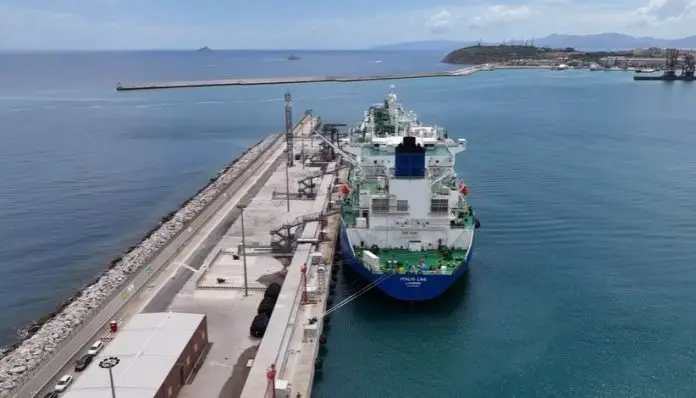This story requires a subscription
This includes a single user license.
The 170,000-cbm Italis LNG, previously known as Golar Tundra, received its first commercial shipment from Eni in July last year.
Eni booked regasification capacity at the FSRU-based facility as part of its strategy to diversify LNG supplies to Italy through its internationally produced equity gas.
In April, the unit received its first LNG cargo from Eni’s Congo FLNG project.
Snam said in its financial report that the unit regasified a total of 2.45 billion cubic meters with 27 unloads from LNG carriers in the first nine months of 2024.
In total, the unit received 39 LNG cargoes since the start of operations, it said.
Including its Panigaglia onshore terminal in Liguria, Snam regasified 3.42 bcm of LNG during the nine-month period, a rise of 44.3 percent year-on-year.
Snam said Panigaglia LNG regasified 0.97 billion cubic meters in the first nine months of 2024, down from 2.27 billion in the same period in 2023, which was a “direct effect of the Russo-Ukrainian conflict on the gas market.”
Italian volumes down due to FSRU Toscana maintenance
Including the Adriatic LNG terminal and the OLT Offshore’s FSRU Toscana, Italian volumes decreased 9.5 percent year-on-year to 10.89 bcm in the nine-month period, according to Snam.
Snam said that about 120 LNG cargoes arrived in Italy during the period, covering 25 percent of gas demand and providing large diversification.
One-third of these volumes came from the US, one-third from Qatar, and one-fourth from Algeria, while the rest came from other locations around the globe.
Adriatic LNG volumes reached 6.76 bcm during the period, up 3.8 percent on year, while FSRU Toscana volumes dipped 78.5 percent year-on-year to 0.66 bcm due to scheduled maintenance.
OLT Offshore recently said it expects its FSRU Toscana to resume operations and receive the first LNG cargo in November following the completion of planned shipyard activities in Marseille, France.
Snam holds a 49.07 percent stake in the LNG terminal, while Igneo Infrastructure Partners owns a 48.24 percent share.
Adriatic LNG
Adriatic LNG import terminal achieved a new record in the first half of this year with deliveries to the grid from its facility in the Adriatic Sea.
The regasification terminal located off the Veneto coast sent 4.4 bcm of natural gas into the national pipeline network during January-June, covering over 14.2 percent of national gas consumption and confirming itself as the third entry source for Italian gas imports.
Earlier this year, Snam decided to increase its stake in the Adriatic LNG terminal after Rotterdam-based storage terminal owner VTTI and German asset manager IKAV joined forces to take a majority stake in the facility.
Following the completion of the transaction, Snam will own 30 percent, and VTTI will own 70 percent of Adriatic LNG.
Previously, US energy firm ExxonMobil had a 70.7 percent stake in Adriatic LNG, while state-owned LNG giant QatarEnergy held 22 percent and Snam owned 7.3 percent.
Snam CEO Stefano Venier said during the company’s earnings call that the EU Commission just approved the transaction.
“It’s a key milestone toward the successful closing of the transaction, which is expected by the beginning of December,” he said.
LNG can replace pipeline gas shortage
During the call, Venier was also asked about the supply balance in Europe as the pipeline gas transit agreement between Russia and Ukraine expires at the end of this year.
“With respect to the transit through Ukraine, the total volumes on a yearly basis is around 15 billion cubic meters. And with respect to total consumption in Europe, that is by far higher than 300 million cubic meters,” he said.
“So, this part can be covered by leveraging upon the LNG facilities that have been put in place in the last 12 months to 18 months,” he said.
He noted that Gastrade’s FSRU-based facility is now operational.
Gastrade’s 153,600-cbm FSRU Alexandroupolis received its first commercial LNG shipment from Norway on October 3.
He also said that Snam’s new FSRU-based facility can supply these volumes, and other LNG terminals in Europe.
“Those have appropriate flexibility to, let’s say, offset this possible 15 bcm shortfall,” he said.
In December last year, Snam completed the purchase of BW LNG’s 2015-built FSRU BW Singapore for about $400 million.
The FSRU, with a maximum storage capacity of about 170,000 cubic meters of LNG and a nominal continuous regasification capacity of about 5 billion cubic meters per year, will serve the Ravenna terminal in the Adriatic Sea.
“We are progressing with the Ravenna FSRU terminal works, which are completed at 80 percent on average,” Venier said.
He said the asset is expected to be operational by the first quarter of 2025, with the FSRU expected to reach Italy by year-end.

